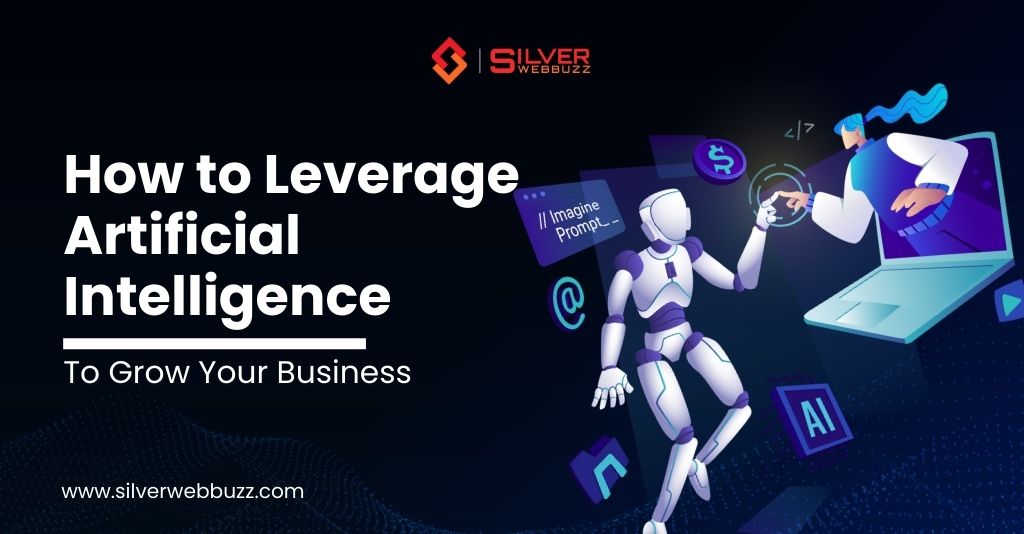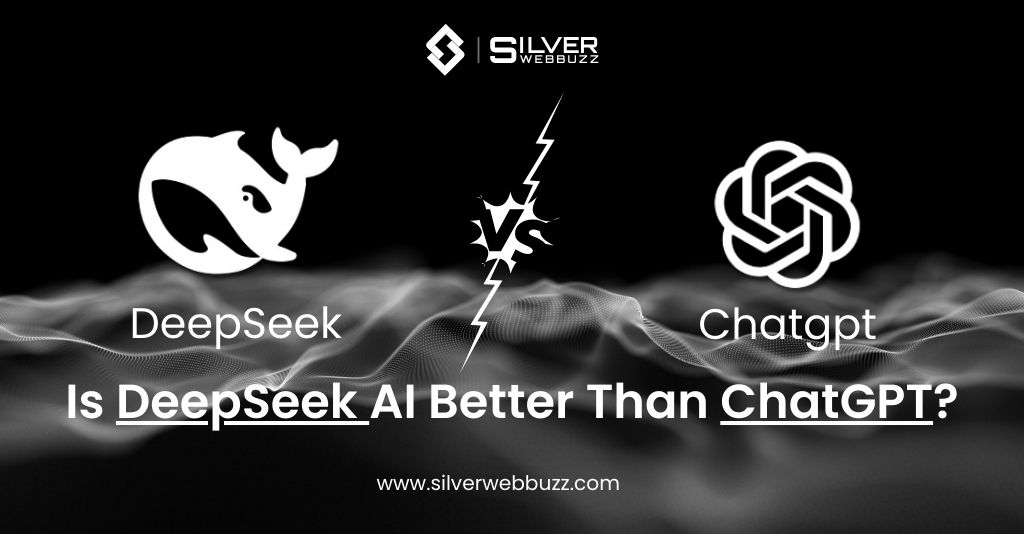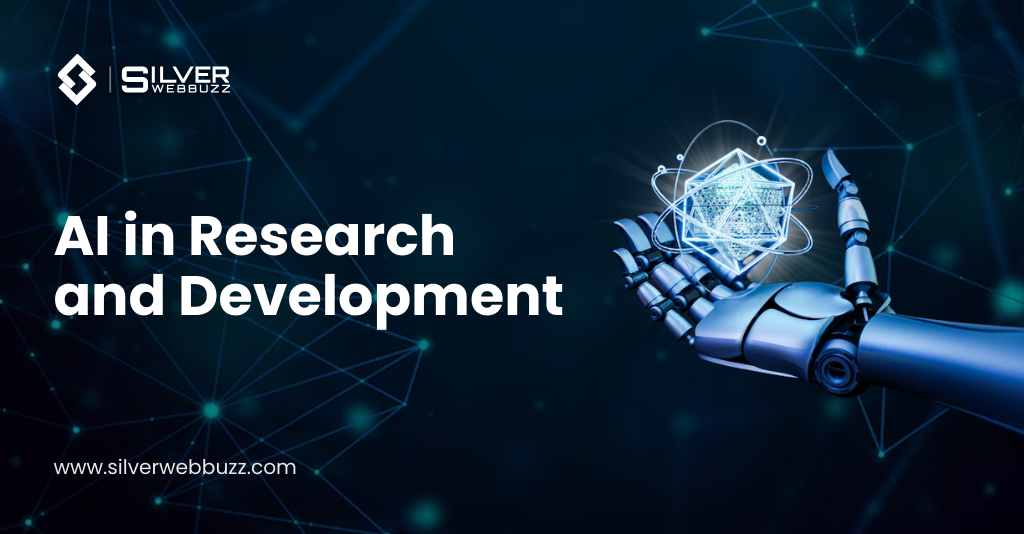Artificial Intelligence (AI) is revolutionizing industries by enabling applications with automation, predictive analytics, and intelligent decision-making capabilities. AI applications range from chatbots and virtual assistants to complex machine learning models used in healthcare, finance, and e-commerce. The integration of AI enhances efficiency, improves user experience, and drives business growth across various domains. Let’s go with AI App Development Cost along with other things that you need to know.
Why Understanding AI Development Costs is Crucial?
AI application development requires a significant financial investment, which varies depending on complexity, use case, and AI model sophistication. Businesses must understand these cost factors to plan their budgets effectively and ensure a smooth development process. A well-structured cost analysis helps prevent unexpected financial challenges and maximizes return on investment.
Factors Influencing AI App Development Costs
Several key factors determine the overall cost of AI application development. The complexity and features of the AI system play a crucial role, as basic applications cost less, whereas advanced AI-powered solutions require substantial resources. The type of AI model being used, whether a pre-trained model or a custom-built solution, also impacts the cost. Additionally, the development team’s structure (in-house, outsourced, or freelance) and the required infrastructure, including cloud services and third-party APIs, contribute to the final expenses.
How Much Does AI Application Development Cost Based on the Phases?
Planning & Research
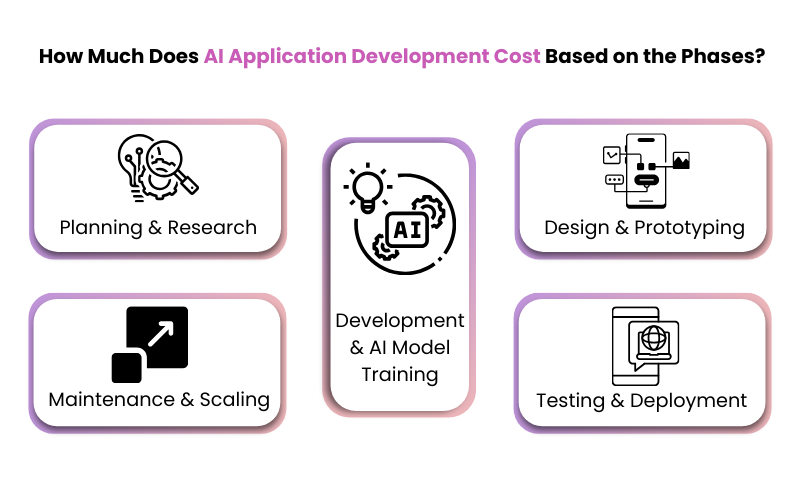
The planning and research phase involves conducting market analysis, competitive research, and a feasibility study to determine the viability of an AI-powered application. This stage is crucial in identifying target users, key functionalities, and business objectives. A thorough feasibility assessment ensures that the project has a clear roadmap, reducing potential development risks and unexpected expenses.
Design & Prototyping
During the design and prototyping phase, UI/UX designers create wireframes and interactive prototypes to visualize the application’s look and feel. User journey mapping is performed to ensure a seamless experience and intuitive navigation. By finalizing the design before development begins, businesses can prevent costly revisions and improve overall user satisfaction.
Development & AI Model Training
The development phase includes backend architecture, database setup, and the implementation of AI/ML models. AI model training is a resource-intensive process requiring large datasets and high computational power. Depending on the application’s complexity, development can take weeks or months, significantly impacting costs. Developers also ensure seamless integration between the AI model and application functionalities.
Testing & Deployment
Before launching an AI application, rigorous testing is conducted to identify and fix bugs, optimize performance, and ensure security compliance. Performance testing ensures that the AI model functions efficiently under different conditions. Once testing is complete, the application is deployed on cloud or on-premise infrastructure, making it accessible to users.
Maintenance & Scaling
AI applications require continuous monitoring and updates to ensure optimal performance. AI models need regular retraining with new data to improve accuracy and adaptability. Additionally, as user demand grows, businesses may need to scale the application, requiring additional infrastructure investments. Regular maintenance helps prevent system failures and enhances user experience.
AI App Development Cost Based on Its Type or Platform
AI Chatbot Development
AI chatbots enhance customer service by providing instant responses, automating support, and improving engagement. Basic chatbots with rule-based responses cost less, whereas advanced NLP-based chatbots using AI-driven conversation models require higher investment. The cost depends on the level of AI training, integration with messaging platforms, and scalability.
AI-Powered Mobile App Development
AI-powered mobile applications incorporate machine learning algorithms to personalize user experiences, automate tasks, and optimize performance. These apps are used in e-commerce, healthcare, and finance for intelligent recommendations and data-driven insights. The cost varies based on the AI model’s complexity and the level of integration required.
AI-Based SaaS Platforms
Software as a Service (SaaS) platforms powered by AI offer scalable, cloud-based solutions for businesses. AI SaaS applications include data analytics tools, automated content generators, and AI-driven CRM platforms. Development costs depend on the platform’s scope, the number of users it supports, and the computational power required for AI model execution.
AI in E-Commerce, Healthcare, Finance, etc.
AI-driven applications in industries such as e-commerce, healthcare, and finance enable personalized experiences, fraud detection, and predictive analytics. For example, AI in e-commerce recommends products based on user behavior, while AI in healthcare assists with diagnostics. The development cost varies based on the industry, data sensitivity, and required compliance measures.
Cross-Platform vs. Native AI Apps
Cross-platform AI apps are cost-effective as they work on multiple devices with a single codebase, but they may compromise performance. Native AI apps, built specifically for iOS or Android, offer optimized performance and seamless AI model integration but require a higher investment. Choosing the right approach depends on the business goals and target audience.
How to Estimate AI Development Cost?
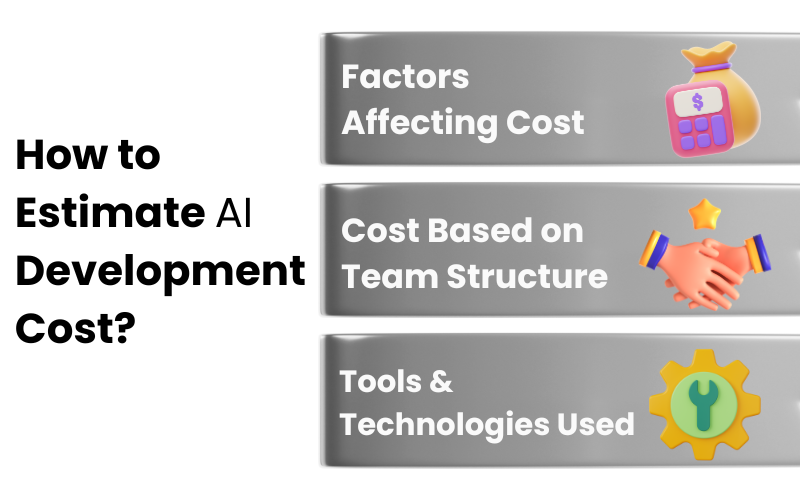
Factors Affecting Cost
AI development costs depend on various factors, including the complexity of AI algorithms, the type of AI model used, and third-party service integrations. Custom AI models require significant investment in training data and computational resources, while pre-trained models help reduce costs. The choice of technology stack also influences the overall budget.
Cost Based on Team Structure
The development team structure impacts cost estimates significantly. In-house teams require salaries and infrastructure, while outsourcing to AI development firms provides flexibility at a lower cost. Freelancers can be a budget-friendly option for smaller AI projects but may lack scalability for enterprise applications.
Tools & Technologies Used
AI development relies on various tools and technologies, such as TensorFlow and PyTorch for AI model training, and cloud platforms like AWS AI and Google Cloud AI for deployment. Open-source frameworks help reduce costs, while custom AI solutions demand higher investment in development and testing.
How to Leverage Artificial Intelligence to Grow Your Business
Hidden Costs in AI App Development
AI Model Training & Dataset Collection Costs
Training an AI model requires high-quality datasets, which can be expensive to collect and annotate. The cost of acquiring proprietary data, cleaning it, and ensuring accuracy adds to development expenses.
Cloud Computing & Infrastructure Costs
AI applications require significant computing power, which increases cloud service expenses. Hosting AI models on cloud platforms like AWS or Google Cloud incurs costs based on storage, data processing, and scalability needs.
API & Third-Party Service Costs
AI applications often rely on external APIs for speech recognition, language processing, or image recognition. These third-party services charge based on usage, impacting overall AI development expenses.
Regulatory Compliance & Security Measures
Industries like healthcare and finance require compliance with regulations like GDPR and HIPAA. Implementing security measures and obtaining certifications add to development costs but ensure data protection and legal compliance.
How to Reduce AI Development Costs?
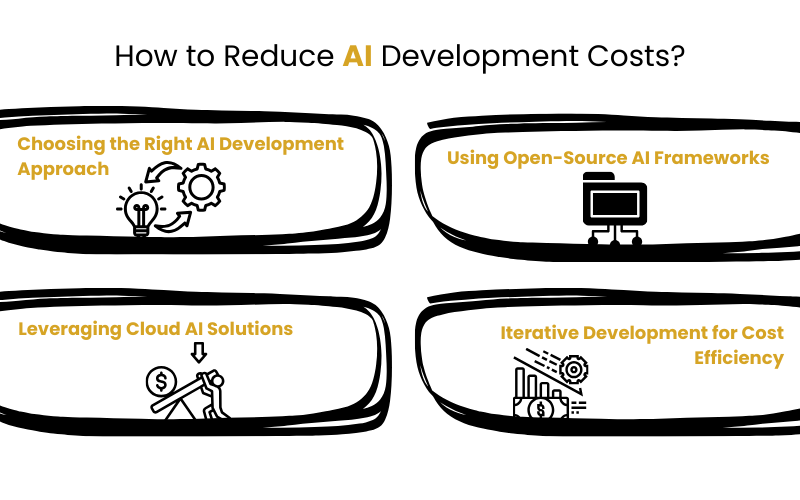
Choosing the Right AI Development Approach
Selecting the best approach for AI development significantly affects costs. Businesses can choose between pre-trained AI models and custom AI solutions. Pre-trained models from platforms like OpenAI and Google Cloud AI offer a cost-effective way to integrate AI capabilities. Custom AI solutions, while expensive, provide tailored functionalities and greater control over data and model performance.
Using Open-Source AI Frameworks
Leveraging open-source AI frameworks like TensorFlow, PyTorch, and Scikit-learn can save substantial costs on licensing and software development. These frameworks come with extensive community support, reducing the need for proprietary software and lowering the initial investment in AI model development. Open-source tools also facilitate rapid experimentation and iteration.
Leveraging Cloud AI Solutions
Cloud-based AI services, such as AWS AI, Google AI, and Azure AI, provide scalable and cost-efficient solutions. These platforms offer AI capabilities like machine learning, natural language processing, and image recognition, which can be integrated without the need for expensive in-house infrastructure. Cloud solutions follow a pay-as-you-go model, allowing businesses to scale costs based on demand.
Iterative Development for Cost Efficiency
Following an iterative development approach, such as Agile methodology, helps in controlling costs by breaking the AI development process into manageable phases. By launching an MVP (Minimum Viable Product) first, businesses can test their AI application with limited investment and optimize features based on user feedback. This prevents unnecessary spending on features that may not be valuable to end-users.
AI App Development Cost for Renowned Startups
Case Studies of AI-Powered Startups
Several successful startups have invested heavily in AI technology, resulting in groundbreaking innovations. For example, OpenAI started as a research organization with an initial funding of millions, later commercializing AI-powered applications like ChatGPT. Similarly, AI-powered fintech and healthcare startups have secured funding exceeding $100M due to their potential to disrupt industries.
Budget Allocation for AI Innovation
AI development for startups requires a strategic budget allocation to balance innovation with financial sustainability. Typically, a startup’s AI budget is divided into research and development (30%), AI model training (40%), infrastructure and deployment (20%), and maintenance and scaling (10%). Investing wisely in these categories ensures long-term growth while optimizing expenses.
Average Cost to Develop an AI App
Cost Range for Basic, Moderate, and Advanced AI Apps
AI app development costs vary based on complexity. A basic AI app with simple automation or rule-based AI may cost between $30,000 – $80,000. A moderately complex AI app with machine learning capabilities and cloud integration could range between $80,000 – $200,000. Highly advanced AI applications, such as deep learning-powered recommendation engines or autonomous AI systems, can cost upwards of $200,000 – $500,000+.
Cost Estimation for Small Businesses vs. Enterprises
Small businesses can develop AI applications at a lower cost by utilizing pre-trained models and cloud AI solutions, keeping expenses between $30,000 – $100,000. In contrast, enterprises requiring custom AI solutions, extensive data processing, and large-scale deployment may invest anywhere from $150,000 to $500,000 or more. The budget should align with business needs and expected ROI.
How Silverwebbuzz Can Help You Optimize AI App Development Costs?
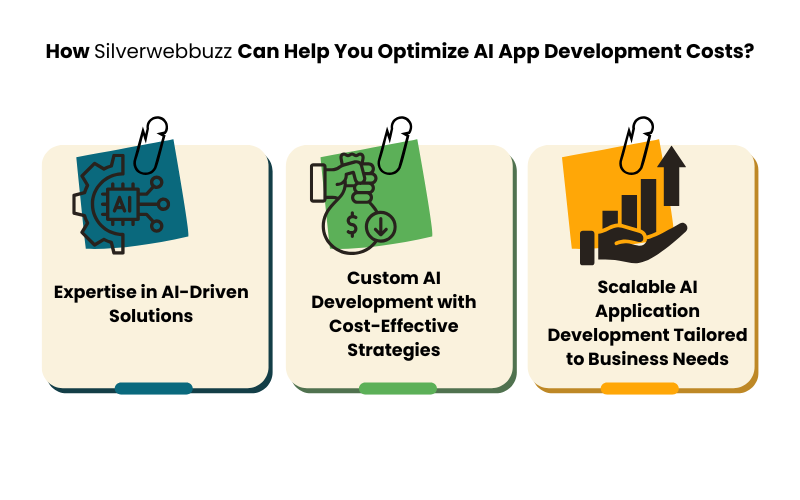
Expertise in AI-Driven Solutions
Silverwebbuzz specializes in developing AI-powered applications tailored to diverse business needs. With expertise in AI/ML technologies, they help businesses implement intelligent solutions that drive growth and efficiency.
Custom AI Development with Cost-Effective Strategies
The company offers flexible AI development strategies, utilizing pre-trained models and cloud-based AI to reduce costs. Their expert team evaluates business requirements and suggests the best approach to minimize development expenses without compromising functionality.
Scalable AI Application Development Tailored to Business Needs
Silverwebbuzz ensures that AI applications are built with scalability in mind, enabling businesses to expand their AI capabilities as they grow. Their solutions are designed to be adaptable, allowing seamless integration with evolving technologies and market demands.
Conclusion
AI application development costs depend on various factors, including complexity, AI model type, and infrastructure requirements. Understanding these cost elements helps businesses plan budgets efficiently and optimize investments in AI technology. To make AI development cost-effective, businesses should evaluate their AI needs, choose the right development approach, leverage open-source frameworks, and adopt cloud-based solutions. An iterative development strategy helps in managing costs while ensuring quality. For businesses looking to build cost-efficient AI applications, Silverwebbuzz offers expert solutions tailored to their budget and industry needs. Contact them today for a consultation and start your AI transformation journey.

